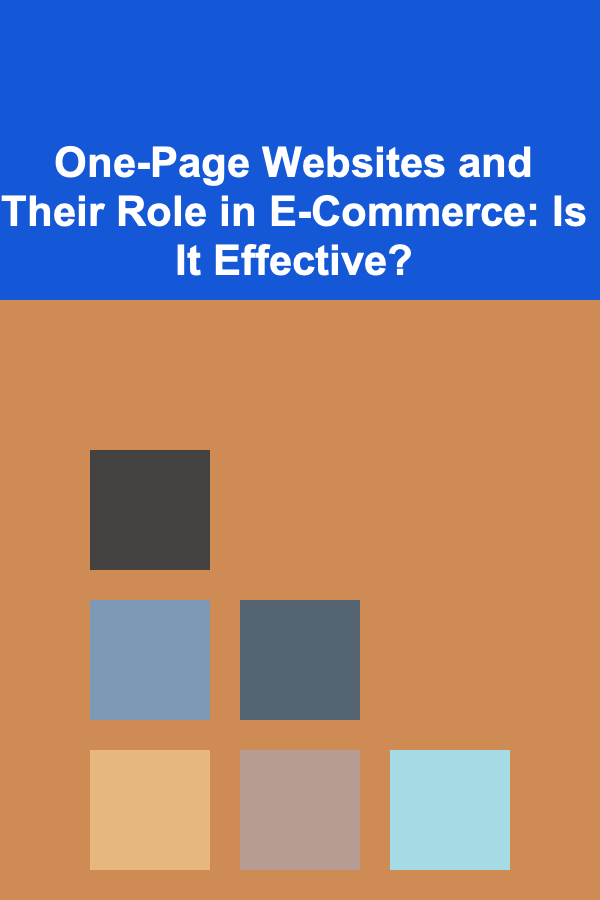
One-Page Websites and Their Role in E-Commerce: Is It Effective?
ebook include PDF & Audio bundle (Micro Guide)
$12.99$11.99
Limited Time Offer! Order within the next:

The rise of e-commerce has brought about a major shift in how businesses operate and how consumers engage with products and services online. A critical aspect of e-commerce success is website design, as the website serves as the primary interface between the business and its customers. In recent years, a particular trend has emerged: the one-page website.
One-page websites have become increasingly popular in a variety of industries, including e-commerce. A one-page website is a type of website that condenses all its content into a single web page, as opposed to traditional multi-page websites. While it offers a sleek and simplified user experience, it raises important questions for businesses in the e-commerce space. Are one-page websites truly effective for e-commerce? Do they provide the same level of functionality and conversion rates as traditional websites?
In this article, we will explore the concept of one-page websites, analyze their role in e-commerce, evaluate their benefits and limitations, and provide insights on whether or not they are a viable option for e-commerce businesses.
What is a One-Page Website?
A one-page website, also known as a single-page website, is a type of website where all content is contained within a single page. The site typically uses scrolling to guide users through various sections, such as an introduction, product listings, testimonials, and a contact form. Rather than clicking through multiple pages or navigating between different sections of the site, users can scroll vertically or use anchor links to jump to specific sections of the same page.
Key Characteristics of One-Page Websites:
- Single Page Design: The entire content of the website is displayed on one page.
- Navigation: Typically uses anchor links or scrolling to navigate between sections.
- Simplified Layout: One-page websites usually have a clean and minimal design with a focus on key messaging and conversions.
- Responsive Design: One-page websites are often mobile-optimized to ensure smooth scrolling and navigation on smaller devices.
This type of website is commonly used for portfolios, personal blogs, event sites, and even e-commerce stores. The one-page format is often considered ideal for delivering a straightforward and seamless experience, as it eliminates the complexity of traditional, multi-page navigation.
The Role of One-Page Websites in E-Commerce
In the e-commerce space, the goal of a website is to drive sales, engage customers, and create a frictionless shopping experience. Traditionally, e-commerce websites consist of multiple pages---home, product listings, individual product pages, checkout, and customer support sections. However, with the rise of mobile commerce and the need for faster, more user-friendly experiences, some businesses are opting for one-page websites.
One-page websites in e-commerce tend to focus on a streamlined shopping journey, often with clear calls to action, prominent product images, and minimal distractions. The central question, however, is whether such websites can be effective in achieving the primary goals of an e-commerce business---conversions and customer retention.
Benefits of One-Page Websites for E-Commerce
Despite some skepticism, one-page websites offer several advantages, particularly in terms of user experience and design. Here are some reasons why one-page websites can work effectively for e-commerce:
1. Simplified User Experience
One-page websites are known for their simplicity. Since everything is presented on a single page, users don't have to navigate through multiple pages or wait for new pages to load. This simplified experience can be particularly beneficial for mobile users who are accustomed to scrolling through social media feeds and apps. For e-commerce businesses, a simplified experience means that customers can easily view and purchase products without feeling overwhelmed by complicated menus or too many choices.
In e-commerce, the goal is often to reduce friction at every stage of the user journey. With fewer clicks, a one-page website offers an effortless experience that leads users directly to the point of sale.
2. Faster Loading Times
Loading speed is a critical factor in the success of an e-commerce website. According to research, even a one-second delay in page loading time can result in a significant decrease in conversions. One-page websites, because they load all the content in a single request, tend to be faster than traditional multi-page websites that require multiple requests to load various assets.
For e-commerce businesses, faster loading times can lead to higher conversion rates and better customer retention. A faster, smoother user experience is especially critical in e-commerce, where customers often make purchasing decisions quickly and expect a seamless shopping experience.
3. Mobile Optimization
With the rise of mobile shopping, e-commerce businesses are increasingly focusing on creating mobile-friendly experiences. One-page websites are often designed with mobile users in mind, as they are inherently easier to navigate on small screens.
The simple, scrollable design of a one-page website means that users can easily access product information, add items to their cart, and complete purchases with minimal effort. Furthermore, one-page websites often eliminate the need for complex navigation, making it easier for users to find exactly what they're looking for.
4. Effective Storytelling and Brand Messaging
One of the key advantages of one-page websites is their ability to tell a cohesive story. Instead of being divided across multiple pages, all content is presented in a single, continuous flow. This can be an excellent opportunity for e-commerce businesses to build a strong narrative around their brand and products.
For example, an online clothing store might use the one-page format to highlight their brand values, show off new collections, feature customer reviews, and provide clear calls to action in a logical order. This narrative structure can guide customers through the brand's story while encouraging them to make a purchase.
5. Higher Conversion Rates (Potentially)
Because one-page websites are focused on simplicity and ease of use, they can potentially lead to higher conversion rates. With fewer distractions and a more straightforward design, users are more likely to follow through with a purchase. The single-page format also allows for prominent placement of calls-to-action (CTAs), such as "Buy Now" or "Add to Cart" buttons.
In fact, many e-commerce businesses use one-page websites to run promotional campaigns or offer limited-time deals, where the streamlined layout makes it easier for users to act quickly. For example, a one-page website might feature a product sale or special offer that encourages visitors to complete their purchase in a short amount of time.
Limitations of One-Page Websites for E-Commerce
Despite the many advantages, one-page websites are not without their limitations. These limitations need to be carefully considered by any e-commerce business thinking about adopting a one-page website format.
1. Limited Product Display
One of the most significant limitations of a one-page website in e-commerce is that it can be difficult to showcase a large inventory. E-commerce stores typically feature many products with varying categories, details, and prices. A single-page website, by its nature, is constrained in terms of space and design flexibility.
For businesses with large product catalogs, a one-page website may not be practical. The site might become cluttered or too long for users to navigate efficiently. Even with smooth scrolling, the sheer amount of content required to display multiple products may overwhelm users, leading to a poor user experience.
2. SEO Challenges
Search engine optimization (SEO) is an essential aspect of driving traffic to an e-commerce website. Traditional multi-page websites benefit from multiple URLs, each optimized for specific keywords. This allows businesses to target various search terms and rank higher for a broader range of keywords.
In contrast, one-page websites typically have only one URL, which can limit SEO opportunities. While it is still possible to optimize a one-page website for specific keywords, it's much harder to target a variety of search queries. Additionally, the lack of individual product pages can make it more difficult to rank for long-tail keywords or product-specific terms.
3. Scalability Issues
E-commerce websites need to grow and evolve with the business. One-page websites, while great for simplicity, can face scalability issues. As businesses expand their product offerings or add new features to their site, the one-page format may become cumbersome.
For example, if an e-commerce business wants to add a blog, customer support section, or a comprehensive FAQ page, the limitations of a one-page website may hinder the process. Expanding a one-page website without overwhelming users with too much information can be difficult, requiring careful design and thoughtful content curation.
4. Limited Analytics and Tracking
Tracking user behavior and conversions is critical for improving website performance. On traditional e-commerce websites, businesses can track specific page visits, such as product pages, category pages, and checkout pages. This granular level of tracking allows businesses to gain valuable insights into user behavior and optimize their site accordingly.
On a one-page website, however, tracking can be more difficult. Because all interactions happen on a single page, it may be harder to measure where users are spending their time or which specific products they are interested in. This lack of detailed analytics can limit the ability to make data-driven decisions.
When Should E-Commerce Businesses Use One-Page Websites?
While one-page websites are not suitable for all e-commerce businesses, they can be highly effective in specific situations. Here are some scenarios where a one-page website may be the right choice for an e-commerce business:
1. Single Product Stores
If an e-commerce business only sells a single product or a limited selection of products, a one-page website can work exceptionally well. This format allows businesses to focus all their energy on presenting a single product in the best possible light, highlighting key features, benefits, and calls to action.
For example, a business selling a unique, high-quality gadget or a limited-edition product could use a one-page website to tell a compelling story about the product and drive conversions without the need for a complex multi-page site.
2. Promotional Campaigns
One-page websites are also ideal for temporary, promotional campaigns or limited-time offers. For instance, an e-commerce business could create a one-page site to promote a flash sale, seasonal discount, or new product launch. The streamlined design ensures that visitors can quickly access the promotion and complete their purchase without distractions.
3. Branding and Portfolio Websites
In some cases, e-commerce businesses may want to use a one-page website to showcase their brand, ethos, and story. A one-page website can serve as an effective portfolio or landing page for a business that is focused more on branding than offering a wide range of products.
Conclusion
One-page websites can be highly effective in certain e-commerce scenarios, particularly for businesses that sell a limited range of products, run targeted promotional campaigns, or focus heavily on branding. They offer benefits such as simplified user experiences, faster loading times, and mobile optimization, all of which contribute to better conversion rates.
However, one-page websites also have significant limitations, including challenges related to SEO, product display, scalability, and analytics. E-commerce businesses with larger inventories or more complex needs may find that a traditional multi-page website is better suited to their goals.
Ultimately, the decision to use a one-page website for e-commerce should be based on the specific needs and goals of the business. By carefully weighing the advantages and disadvantages, businesses can determine whether a one-page website is the most effective solution for their e-commerce strategy.
Reading More From Our Other Websites
- [Gardening 101] Seasonal Water‑Saving Practices: Adjusting Your Garden Care Throughout the Year
- [Horseback Riding Tip 101] Best Hand‑Raising Techniques to Strengthen a Horse's Back Without Overworking
- [Personal Care Tips 101] How to Apply Nail Polish for a Special Occasion
- [Home Budget 101] How to Save Money on Groceries: Smart Strategies for Home Budgeting
- [Home Pet Care 101] How to Keep Your Cat Active: Fun Exercise and Playtime Ideas
- [Organization Tip 101] How to Group Plants by Watering Needs for Efficient Care
- [Soap Making Tip 101] Best Exotic Oil Soap Recipes: Exploring Unique Scents & Skin Benefits
- [Home Family Activity 101] How to Host a Family Sports Day in Your Backyard
- [Organization Tip 101] The Benefits of Using a Nail Gun for Trim Work Over Traditional Methods
- [Home Maintenance 101] How to Prevent Water Damage in Your Home

How to Get Paid for Your Opinions (Surveys)
Read More
How to Plan for Major Life Events on a Budget
Read More
How to Use Furniture Layout to Make Your Home Look Bigger
Read More
How To Save Money on Entertainment Subscriptions
Read More
How To Play Sandbox Games for Creative Freedom
Read More
How To Opt Out of Data Sharing with Third Parties
Read MoreOther Products

How to Get Paid for Your Opinions (Surveys)
Read More
How to Plan for Major Life Events on a Budget
Read More
How to Use Furniture Layout to Make Your Home Look Bigger
Read More
How To Save Money on Entertainment Subscriptions
Read More
How To Play Sandbox Games for Creative Freedom
Read More